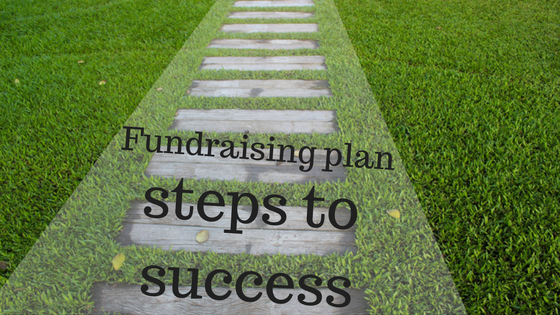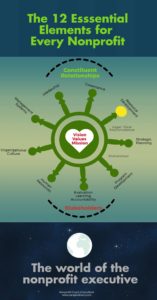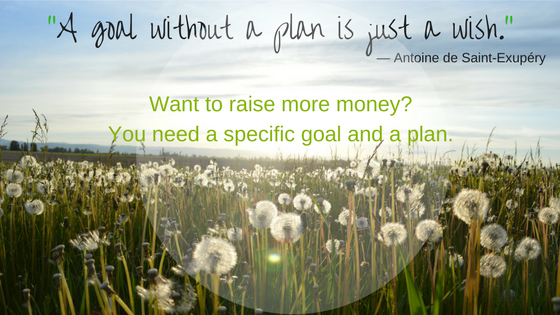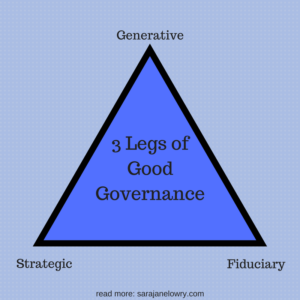 If you haven’t started your Annual Appeal planning by now, you’re already behind.
If you haven’t started your Annual Appeal planning by now, you’re already behind.
You’re probably thinking: Gosh, it’s still summer and school is just starting!
But the truth is that if you want to achieve some real financial and donor relationship goals this year, getting started right now will ensure your boss or board (and you) aren’t disappointed with the return.
So, take time to get your goals set and systems in place first. You’ll thank me later.
Goal-setting
Financial 
You may have already put a number in the budget. How much did say you were going to raise? Was it based on real numbers from last year? Or what you needed to make ends meet? Most of all, get clear in your mind what number you’re shooting for. Because without a goal, you have no way to measure your success.
Donor
Here’s where you can see how you can better interact with your donors. These are the people who care, who love being part of changing the world through you! So set some goals like:
- Whether you can be improving donor retention with improving the stories you share. [This is very important: only 46% of donors gave a 2nd gift!] If your donor retention last year was 40% or 80%, you could set a goal of increasing it by 10-15%.
- How you can reengage donors who didn’t give last year to give again. If you take time to review what they gave for previously or when, you might determine a strategy that fits them.
- Take some time in reviewing your lists to see donor giving trends and see if there are some major donor prospects you haven’t yet developed.
Put together an Annual Appeal Team
Please don’t try to go it alone, even if you’re a solo executive director or development person. Depending on your nonprofit’s size, get a couple of staff, volunteers, or board members to help you. You will need feedback on your story, on segmenting lists, on creating a social media timeline, and people willing to write notes, and to make a visit or some calls to major donors. Therefore, get these people lined up now. Your appeal results will be stronger for it.
Annual Appeal Timeline
Yep, the timeline – that’s how you’ll see you’re already behind. Remember, you’re working on two tracks now: donor engagement, and the whole production aspect of the year end appeal.
Donor engagement timeline:
In the best planning, you’ve already been building relationships with donors. This essential work needs to have already be happening to engage them in how you’re using their support to create impact, to show them that you see them as the fans they are, and to lead them toward wanting to give you a year-end gift. So, what if you haven’t started? And what kind of simple events can you plan in the next two months to see people face-to-face? Set up meetings with the executive director and various donors; get your board to arrange a donor thank-you event; invite a “donor advisory board” of folks to come and hear about your work and offer input.
While you’re getting in some face time with donors, make sure you’re communicating with donors who are giving now – perhaps a welcome pack and special new donor thank you; heartfelt, hand-signed thank-yous that are as personal as possible; or sending a donor-driven, story-focused newsletter right now.
So here’s the annual appeal production timeline you should be working with right now:
NOW
Hold a brainstorming meeting with staff to determine your appeal’s theme and messaging
- The theme is usually 3-5 words that encapsulate the vision you’re working toward. It might be something that fits the journey of a client whose story you will share.
- Whose story will you share? Do you have a picture (and permission to use it)? Since stories drive donations, this is the heart of your appeal. But what if your nonprofit serves at-risk people who need to stay anonymous? Here’s the bottom line when telling their stories.
- Always get written permission from clients before publishing their stories.
- Get creative in shielding personal details and identities of the client unless they are okay with sharing.
- Be transparent about what you are doing. In other words, footnote the story with something like: “While this story is true, the client’s name and image may have been changed to protect privacy. Thank you for understanding.”
- Consider including a donor’s story as part of the annual appeal package. Donors also have a story. And that story is powerful. Their story can help you move others to become donors. People like to be part of a movement. The donor can be the hero of the story.
Create a Production Timeline working back from your mailing date
Things your timeline should include:
- Time to write your annual appeal draft and have it reviewed by all the people who think they should comment
- Time for segmenting your donor database
- Finalizing your draft
- Deciding what else you want to send in the annual appeal such as a slip reminding to ask for a matching gift from an employer
- Purging people from your list who haven’t donated in years
- Talking with your designer, and getting specs and costs from printer and mail house
- Time for your board to write notes on letters
- Making sure you send the database out to the post office to have NCOA
Determine how you want to segment your database
PLEASE DON’T SEND THE SAME THING TO EVERYONE WHO HAS EVER GIVEN YOU MONEY!
- Since every donor is unique and special, they have a different reason for being involved. Hopefully, you’ve categorized that reason somewhere in their record. And someone who’s given you less than $100 should receive a different appeal than someone who gives you $500 or more.
- In the case of smaller donors, ask them to repeat their giving from last year by suggesting a string of amounts that show an increase from that gift that will be reflected on your remit piece or donation landing page.
You’ve got this. Just get your plan, timeline, team, story, and database lined up now. Please don’t wait until October. Get your system in place to assure your success. If you’re having difficulties or want to improve your results, please get in touch.


 Most importantly, you need an understanding among all staff (and that includes program people) that fundraising and relationship building are part of everyone’s job! It’s not the responsibility of one person. Fundraising is important programmatic work.
Most importantly, you need an understanding among all staff (and that includes program people) that fundraising and relationship building are part of everyone’s job! It’s not the responsibility of one person. Fundraising is important programmatic work.


 process, you know that you are setting up a culture that won’t serve you well. I’ve heard about why from governance committees: Fear. Fear that a potential board member will be scared away. But in worrying about scaring them off before they join, you’re forgetting one very important factor. And that factor is the passion they feel for your sector. And that they believe you have the solution to an important community issue. But, that’s just the beginning. A strong board culture includes:
process, you know that you are setting up a culture that won’t serve you well. I’ve heard about why from governance committees: Fear. Fear that a potential board member will be scared away. But in worrying about scaring them off before they join, you’re forgetting one very important factor. And that factor is the passion they feel for your sector. And that they believe you have the solution to an important community issue. But, that’s just the beginning. A strong board culture includes: cond leg, includes setting priorities for your organization, developing and improving various strategies you’re using to meet your mission, and then monitoring their performance. This is often delegated to staff to monitor with very little board oversight. Spend at least 20 minutes of your board meeting on strategic discussion. The third leg of good governance is generative: not just doing work better; but ensuring your organization does better work. Generative thinking includes probing assumptions held in how you decide things, and living the organizational values that should be driving strategy and tactics. Generative mode is often where board members spend the least amount of time, and yet that’s where real governance truly happens. It’s how you make leaps forward. Remember, boards exist to supplement management expertise by asking a different set of questions. High-performing boards spend time in generative mode.
cond leg, includes setting priorities for your organization, developing and improving various strategies you’re using to meet your mission, and then monitoring their performance. This is often delegated to staff to monitor with very little board oversight. Spend at least 20 minutes of your board meeting on strategic discussion. The third leg of good governance is generative: not just doing work better; but ensuring your organization does better work. Generative thinking includes probing assumptions held in how you decide things, and living the organizational values that should be driving strategy and tactics. Generative mode is often where board members spend the least amount of time, and yet that’s where real governance truly happens. It’s how you make leaps forward. Remember, boards exist to supplement management expertise by asking a different set of questions. High-performing boards spend time in generative mode.


